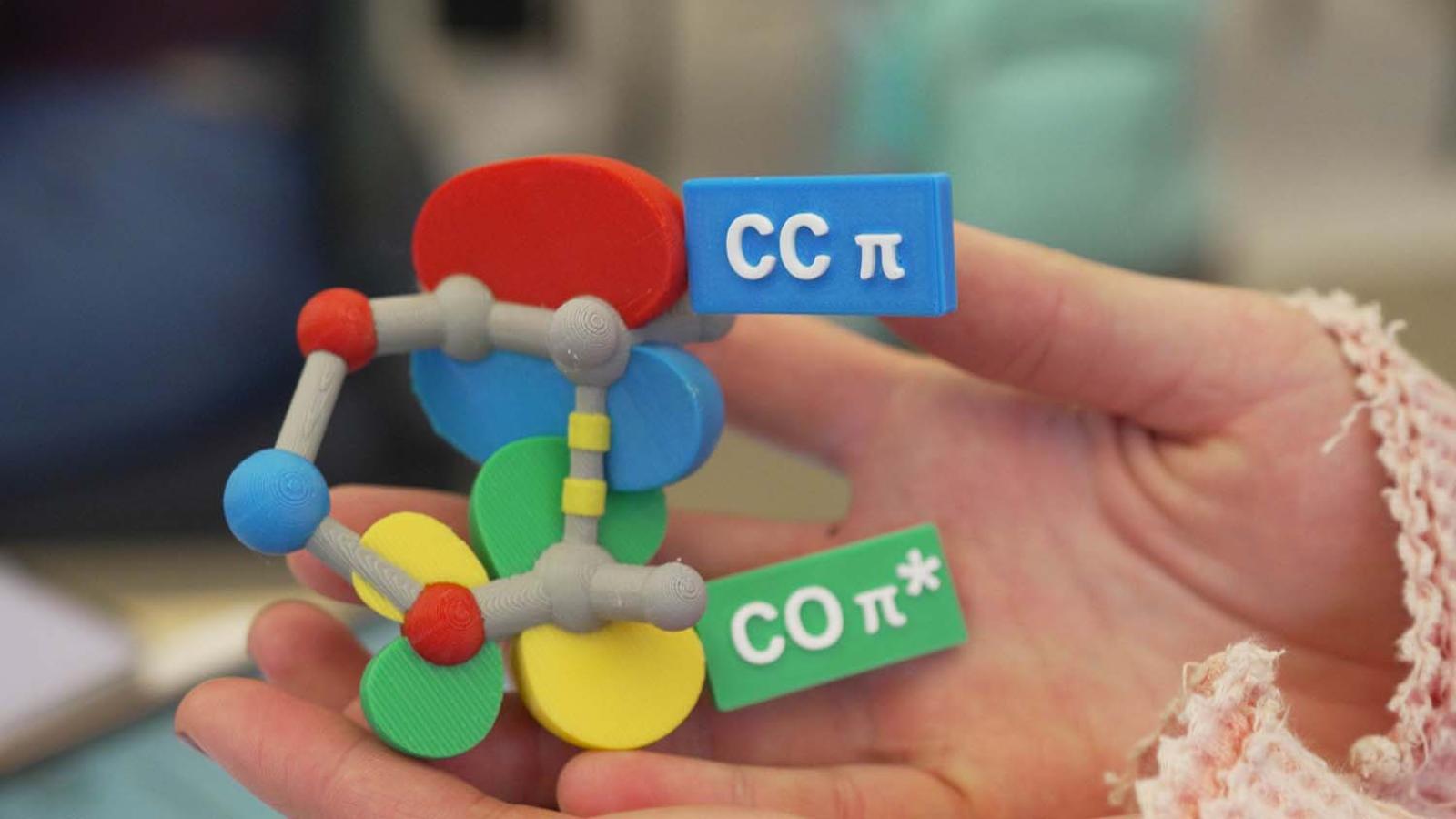The objects are about the size of the toys in kids’ meal packages at fast-food places. They come in the primary colors of red, blue and yellow plus green, each color conveying a specific part of the chemical structure. The collection of shapes, though, is anything but ordinary. Made with a hobby-grade 3-D printer, each one represents the shape and form of a molecular orbital. They are novel enough, and valuable enough as a teaching tool, to be featured on the cover of the Journal of Chemical Education in its April 11 issue.
Had COVID-19 not forced classes online, Daniel J. O’Leary, Carnegie Professor of Chemistry, might not now be using in chemistry classes the objects that he and a student (now alumna) created, models that help his students understand bonds between atoms. But during the pandemic, his daughter, Frances, was home from Purdue University, where she was majoring in computer science and math and was a member of the 3-D printing club. “You should actually 3-D print things for your students,” she suggested.
The thought was intriguing. “I’d like to do orbitals,” O’Leary replied, “because they feature a lot in our discussions.” Orbitals, he explains, are regions of space where electrons live. Using 3-D printing, he could model orbitals and the shapes of molecules in their ground and transition states in chemical reactions and make it easier for students to visualize them.
Creating the models
In spring semester of 2021, as remote instruction continued, O’Leary was teaching what was for him a new course: Computational Chemistry. The class met on Zoom, and each student did an independent project. Michelle Garcia ’22, then a junior chemistry major, learned about the professor’s interest in creating models of orbitals using 3-D printing and took it on as part of her class project. She wanted to learn about bonding in transition metal complexes. They are made from elements in the middle of the periodic table, and some possess unique metal-metal quadruple bonds. She read papers about the topic in the literature, replicated the calculations using Pomona’s High-Performance Computing facility and used the results to create 3-D print files.
Garcia sent the files to O’Leary, who used it to make 3-D printed versions of the molecule she had researched and modeled. “These were not easy calculations, and I was blown away by how excited Michelle was about making these objects. I got excited about the prospect of using them in the classroom,” says O’Leary. He arranged to have one mailed to each student in the class. “We put together these orbital care packages,” says O’Leary, “and the students would unwrap the package during class online.”
At first the orbital models were monochromatic white; one looked vaguely like a pale-colored hippopotamus. Later, O’Leary and Garcia created the models with molecular frameworks in gray and orbitals in colors standardized in the chemistry literature: blue and green, according to one convention; blue and red for filled orbitals and green and yellow for empty, according to another.
Chemical models students can hold and study
Turning two-dimensional representations of chemical structures into 3-D models that students could hold and examine super-charged the class. “I could draw it on the chalkboard, but it’s more fun to actually see it and hold it,” says O’Leary. “Under the worst conditions of teaching online, it was a real bright spot for me to be learning new things alongside my students.”
For Garcia, the project opened doors to share the joy she finds in science with her family. “I’m a first-generation college student,” she says. “When Professor O’Leary sent me a kit [of models], I was able to show that to my dad and he’s like, ‘Oh, that’s cool!’”
It costs only pennies to make each 3-D printed model. O’Leary and Garcia, along with O’Leary’s daughter, Frances, collaborated on a paper to make the techniques available to others in the field of chemistry education. Garcia, who graduated in 2022, is first author on the paper published in the Journal of Chemical Education. She is now a doctoral student in computational and theoretical chemistry at Dartmouth College and works in the lab of Paul Robustelli ’06, a fellow Sagehen.
O’Leary has expanded the use of orbital models in his organic chemistry classes. Now, he and 12 students from the fall semester 2022 class are working collaboratively on a new paper “basically showing how these things can be used, pedagogically, in a first semester organic class,” he says.
Garcia, who is aiming for an academic career, understands how helpful the models can be. “A lot of organic chemistry is in your head. You have to have good spatial awareness—think of a molecule and flip it around in your head,” she says. “If you need a little bit of practice [at that], it’s going to be more of an uphill battle at the beginning of organic chemistry”—one the models can help students overcome. Says O’Leary, “I’d like to think that these objects are actually making the classroom a more interesting place to be. With them, we’re able to think more deeply about chemical structures and organic reaction mechanisms, and Pomona students want to engage at this level.”
The impact is showing up in unexpected places. “There was a student in the class who was decorating her room with orbitals,” O’Leary says. “To me, it was very heartwarming, because if you’re getting chemistry put up in students’ dorm rooms—that’s a good thing.”
